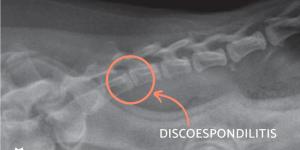Salmonellosis in Dogs - Symptoms & Treatment



See files for Dogs
Dogs can contract Salmonella by ingesting contaminated food or water, as well as by contact with contaminated objects, raw food (especially meat) or infected animals. When this occurs, the dog may suffer gastroenteritis, diarrhea, vomiting and dehydration. In the most severe cases, it can be fatal. Salmonellosis is a zoonotic disease, meaning that is transmitted between animals and people. Following the correct hygiene and food preparation standards is important for the prevention of the disease.
Do you want to learn everything about salmonellosis in dogs? Keep reading this AnimalWised article where we talk about this disease, which is caused by bacteria of the genus Salmonella. Specifically, we look at the symptoms, treatment, diagnosis and prevention of a salmonella infection.
What causes salmonellosis in dogs?
Salmonellosis is an infectious disease of bacterial origin caused by bacteria of the genus Salmonella. Contracted through food, saliva or contact with the feces of an infected animal, it can lead to serious health problems. It is transmitted between animals and humans, which makes it a zoonotic disease.
In fact, the most common serotypes (species of bacteria) found in cases of human gastroenteritis are actually the same serotypes that most frequently occur in dogs. So, if you have ever wondered whether salmonella is transmitted from humans to dogs and vice versa, the answer is yes.
Specifically, it is caused by various serotypes of Salmonella enterica, except for Salmonella typhi, which causes fever and a much more fatal illness in people. Specifically, Salmonella typhimurium is one of the serovars of S. enterica that is most associated with cases of salmonellosis in dogs. It is the same strain of Salmonella which can appear in cats.
How do dogs get salmonellosis?
Salmonellosis is most common in poultry, amphibians and reptiles, but can also be seen in cattle, horses and pigs. It is much less common in cats and dogs. Transmission of salmonellosis is fecal-oral, which means that it can be transmitted to dogs through food, water and objects that are contaminated with fecal matter containing the bacteria. Contact may be made by mouth and subsequent ingestion or direct contact with an affected animal.
Raw meat and eggs are another possible source of infection. The bacterium can survive for months or even years in warm, moist places.
Infected dogs can sometimes act as asymptomatic carriers of the bacteria, shedding one or more serotypes intermittently over a period of up to six months. Dogs with weaker immune systems are more prone to the disease, as are puppies or older dogs.

Pathogenesis of salmonellosis in dogs
Once the dog ingests the bacteria, it invades the mucosa of the small intestine, where it multiplies. This results in lesions in the intestinal epithelium and produces enterotoxins. Even though the immune system begins to attack the bacteria, Salmonella can take advantage of any weakness in the system to cause more damage.
At this point, it lodges in the terminal ileum (the final part of the small intestine), where it multiplies, passes through the intestinal walls and causes serious damage. Once it reaches the large intestine, it exits through the rectum to contaminate more animals, thus continuing the fecal-oral cycle.
Symptoms of salmonella in dogs
Most dogs infected by the Salmonella bacteria are asymptomatic, but they can still cause new infections. Some may manifest some combination of the following clinical signs:
- Diarrhea (sometimes bloody)
- Vomiting
- Fever
- Anorexia
- Weight loss
- Lethargy
- Dehydration
- Miscarriages in pregnant females
It can cause septicemia (bacteria in the blood) and/or sudden death, especially in younger and older animals. Salmonellosis in puppies can cause a syndrome which includes severe neutropenia (low neutrophil count) and, in this way, very similar to enteritis in dogs caused by canine parvovirus.
Diagnosis of salmonellosis in dogs
When diagnosing salmonellosis in dogs, as well as establishing that the clinical signs presented are compatible with salmonellosis, it is important to rule out other possible infectious causes, such as:
- Clostridium perfringens
- Clostridium difficile (C. diff.)
- Campylobacter
- Yersinia enterocolitica
- Giardiasis
- Cryptosporidium
- Other parasitosis
- Parvovirus
- Rotavirus
Variable hematologic alterations may be seen in the dog's blood test, including:
- Non-regenerative anemia
- Lymphopenia (low number of lymphocytes)
- Thrombocytopenia (low number of platelets)
- Neutropenia with left shift
Veterinary diagnosis of Salmonella in dogs can be performed by:
- Stool culture: it can present as positive from the beginning of the infection, reaching maximum positivity in the third week. It is very useful for post-treatment control and to detect chronic carriers.
- Blood culture: it is performed in selective media and the animals can show as positive from the first week of infection. By the third week, the positivity rate drops to 50%.
- PCR: much more sensitive and a faster technique than culture analysis.
Treatment of salmonellosis in dogs
The use of antibiotics for salmonella in dogs should be limited to cases of systemic disease, very severe cases or dogs with immunosuppression. One of the following antibiotics may be prescribed by the veterinarian:
- Ampicillin
- Neomycin
- Amoxicillin
- Sulfamethoxazole/Trimetroprim
- Gentamicin
- Fluoroquinolones
- Chloramphenicol
- Third generation cephalosporins
However, as Salmonella is known for its antimicrobial resistance (an issue that is turning into a major public health problem), an antibiogram should be performed and the most sensitive antibiotic should be administered. Many microbiologists do not recommend antibiotic treatment because allows bacteria to stay on in the intestine after healing. This can affect the intestinal flora and cause strains to become resistant to antibiotics, hence they are only used in the most severe cases, i.e. when trying to save the dog's life.
If affected by salmonellosis, most dogs, especially healthy adult dogs, will have a mild form of the disease or remain asymptomatic. In this way, treatment will usually take place at home. Most importantly, good hydration and nutrition is essential.
In cases of severe dehydration due to dog vomiting and having diarrhea, they will require admission to a veterinary hospital. Treatment will then involve fluid therapy to correct electrolyte imbalances and the use of non-steroidal anti-inflammatory drugs (NSAIDs) to decrease the effects of endotoxemia caused by Salmonella.
Prognosis of salmonellosis in dogs
The prognosis in healthy, vaccinated, dewormed and immunocompetent adults is usually good or very good. On the other hand, in immunocompromised animals, those with a concurrent disease, puppies and the elderly, it can be much more serious as they are more likely to develop septicemia.
Therefore, in the presence of non-specific clinical signs of weakness, vomiting, diarrhea, fever and dehydration in a dog, it is essential to visit the veterinarian. They will then make a diagnosis of this or any other disease with similar symptoms in order to proceed with its treatment.

How to prevent salmonellosis in dogs
To prevent our dogs from contracting salmonella, it is necessary to avoid any possible sources of the bacteria while also keeping good hygiene in the home. Thus, we should:
- Check that the environment where they live is clean and disinfected
- Avoid them consuming dirty or contaminated food and water
- Prevent contact with feces from other animals or objects possibly contaminated with feces.
- Avoid them ingesting raw meat that has not previously been frozen
- If we touch lizards, birds or turtles, or visit a zoo, we should wash our hands before touching our dog. We should also prevent them from ingesting or having contact with these animals.
Since it can be transmitted to people, we should always wash our hands after handling dogs' feces or objects contaminated with them. The same applies for any other potentially affected animals. It is also essential to cook food properly, avoiding raw or undercooked food, especially meat, egg products and unpasteurized milk. These foods are more likely to carry the bacteria, so it is especially important to check them and treat them correctly.
This article is purely informative. AnimalWised does not have the authority to prescribe any veterinary treatment or create a diagnosis. We invite you to take your pet to the veterinarian if they are suffering from any condition or pain.
If you want to read similar articles to Salmonellosis in Dogs - Symptoms & Treatment, we recommend you visit our Bacterial diseases category.
- RW Nelson. (2020). Small Animal Internal Medicine, 6th Edition . Grupo Asís Biomedia SL.
- Veterinary Journal. (2020). They study the prevalence of canine salmonellosis in Spain. Available at: https://www.diarioveterinario.com/t/2065169/estudian-prevalencia-salmonelosis-canina-espana







